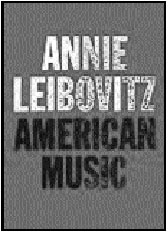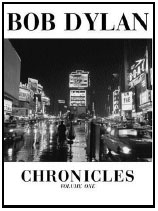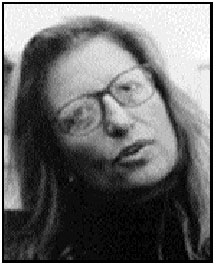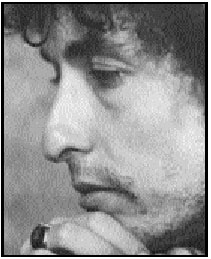[
Back to Issue Features ]
American Music, Chronicles and Blowing on the page
by Joseph Blake
American Music by Annie Leibovitz (Random House; 264 pages; 2003)
Chronicles by Bob Dylan(pages; 2005)
America's gift to the world is its great mongrel culture, the
native tongue and sound, boiled-up in the melting pot. There's
a line that runs from Whitman to Kerouac to Dylan. Jazz, blues,
country folk, gospel, soul, rock and roll and rap set that pot
to boil, and at its best, the succulent gumbo is the sound of
spirit.
 Annie
Leibovitz's American Music and Bob Dylan's Chronicle are recent, book-form attempts to capture that spirit, the heartbeat
blood of the American sonic landscape. Both books offer singular
and insightful peeks behind the music. Annie
Leibovitz's American Music and Bob Dylan's Chronicle are recent, book-form attempts to capture that spirit, the heartbeat
blood of the American sonic landscape. Both books offer singular
and insightful peeks behind the music.
Like acid flashes, Leibovitz's intimate portraits of American
musicians and Dylan's guileless autobiographical images danced
in the guitar din of Bob's recent show at Victoria's new arena.
Dressed in cowboy-black, eyes darting beneath a white, wide-brimmed
flat-top, Dylan perched stage left, directing his glorious, five-piece
band with weird Monk-like keyboard propulsion. He came centre-stage
on several songs to blow scorched-earth harmonica solos, but most
of the show Dylan immersed his vocals in the band's collective
roar. Spread-eagled and swaying while hunched daintily over the
keys, the 65 year old musician growled and crooned and sneered
out his classic lyrics over seething, guitar-driven, roadhouse
roar and playful, juicy swing. In front of an adoring, cross-generational
packed arena, Bob reinvented his songs, singing dramatically above
searing, born-again forms.
 April's
show at the Paramount in Seattle introduced this new band with
explosive, birth-like rawness. Four months later in Victoria,
Dylan and company were still tinkering with their spontaneous,
high-wire act on tunes like the flawed New Morning, but for most
of the two-hour show their groove was spectacularly daring, wild
and together. Dylan didn't encore with his most famous song (take
your pick), but building from a withering version of Maggie's
Farm to an even harder rocking and raunchy Highway 61, Dylan was
masterful. By the time his encores capped the evening with a sweetly
bruised reading of Don't Think Twice and an apocalyptic All Along
The Watchtower, Dylan had covered the waterfront, capturing the
scope of American music from Blind Willie McTell to Hendrix and
beyond. When I look at Leibovitz's beautiful images, Dylan's music
is the soundtrack. I can still hear the inspired roar. April's
show at the Paramount in Seattle introduced this new band with
explosive, birth-like rawness. Four months later in Victoria,
Dylan and company were still tinkering with their spontaneous,
high-wire act on tunes like the flawed New Morning, but for most
of the two-hour show their groove was spectacularly daring, wild
and together. Dylan didn't encore with his most famous song (take
your pick), but building from a withering version of Maggie's
Farm to an even harder rocking and raunchy Highway 61, Dylan was
masterful. By the time his encores capped the evening with a sweetly
bruised reading of Don't Think Twice and an apocalyptic All Along
The Watchtower, Dylan had covered the waterfront, capturing the
scope of American music from Blind Willie McTell to Hendrix and
beyond. When I look at Leibovitz's beautiful images, Dylan's music
is the soundtrack. I can still hear the inspired roar.
At 24, Annie Leibovitz began a 13-year career as Rolling Stone's
ace photographer. She was a student at San Francisco Art Institute
until she parlayed a portfolio of painterly, night-school photos
into her 1970 debut with the music magazine just as Jann Wenner
and shifting Baby Boom demographics pulled Rolling Stone into
the mainstream.
Leibovitz went out on the road with the Rolling Stones in 1975
where she, "learned how music is made." As she explains in one
of her book's short essays, "I had an idea at that point about
how musicians lived, but not about how music is made."
Earlier in the same essay, Leibovitz analyzes her art and its
place in the music. "It seemed to me that a concert was the least
interesting place to photograph a musician. I was interested in
how things got done. I liked rehearsals, backrooms, hotel rooms
-- almost any place but the stage. And even if I was a fan of
someone's music, the photograph came first. It was always about
taking the picture."

An animated Annie Leibowotz
|
The seeds of American Music were sewn in the Mississippi Delta
on a 21st century trip down legendary Highway 61. After her stint
at Rolling Stone and over two decades as contributing photographer
at Vanity Fair and Vogue, two best-selling books, and numerous
awards, Leibovitz's American Music was born of a "desire to return
to my original subject and look at it with a mature eye." The
resulting photographs conjure up what music writer Greil Marcus,
riffing on poet Kenneth Rexroth's "old free America", has called
"the old weird American, the hidden republic of music."
Leibovitz's camera carves a landscape of haunting faces framed
by juke joints and jazz halls, the Carter family's front porch
and seedy, Hollywood hotel rooms, soulful clapboard churches and
boat-sized convertibles on a sticky southern road all the way
to Graceland. Her photos are brilliantly lit black and white,
carved-in-stone portraits punctuated by punch-drunk, psychedelic
colour shots of the rock and roll circus. Music stars and forgotten
or unknown musicians sit or strut with equal dignity, intimacy
and power before Leibovitz's camera.
Describing her passionate reaction to the beauty and richness
of the Fisk Jubilee Singer's gospel music and the Treme Brass
Band's playing at a New Orleans jazz funeral, Leibovitz writes,
"I felt privileged to be able to listen to these people play."
The photographer's passion for the dynamic, inclusive American
music form is made deeply personal by a moving, photographic tapestry
of musicians ranging in age from Pete Seeger to Norah Jones. Most
grew out of road trips visiting musicians in the Mississippi Delta,
Texas, Tennessee, New Orleans, California, Leibovitz's New York
City boroughs, and the wilds of New Jersey. Her camera also captured
majestic images of musical elders shortly before their deaths
in the new century. A handful of earlier work from the 1970s includes
penetrating portraits of Dylan, Ray Charles, Louis Armstrong,
Tina Turner, Joan Baez, Jerry Garcia, Chuck Berry and Bo Diddley.

A pensive Robert Zimmerman
|
Some photos are haunting, others warming, all are moving. They
capture Miles Davis' defiant, darting eyes, Iggy Pop's road-scarred
animal nakedness, and a surprisingly domestic Tina Turner in hair
curlers. Johnny and Rosanne Cash are caught playing guitars on
the front porch while hill country blues rocker Jessie Mae Hemphill
sits stroke-weakened, a dog on her lap, but with eyes still smoldering
above high, Indian-blood and black cheekbones. A spooky, gorgeously
lit black and white shot of Hubert Sumlin and Pinetop Perkins
at the Maple Leaf in New Orleans looks 100 years old, but was
taken in 2003.
All the photos have a timeless quality, just like the music.
Patti Smith writes in a short autobiographical contribution
to the book, "Our music is family unrelated by blood, as Whitman
might say, it contains multitudes."
Other well-known music figures including Steve Earle, Mos Def,
Beck, and Ryan Adams contribute their thoughts too. "Experiencing
different styles is a consequence of my own experience and I let
them emerge in my music, with their inherent humor, freneticism,
boredom and darkness," writes Beck in his insightful essay. "The
holes in the filter are bigger now. The desire to homogenize is
waning. Varieties are giving way to varieties. The shape of the
wave is stranger than anybody could imagine. I always wanted to
get a better look before it drowned me."
I highly recommend that you grab a copy of American Music and
dive in!
If you haven't read Dylan's Chronicles or listened to his most
recent CD, Love and Theft, what are you waiting for? Chances are
you might have missed the Bob Dylan Show when it rolled through
western Canada mid-July too, but you can still catch up with Dylan's
words and music and get ready for Martin Scorsese's PBD documentary,
No Direction Home, a television portrait of Bob scheduled for
September.
In Chronicles, the notoriously private musical legend has produced
a sketchy, uneven, self-portrait packed with surprising slivers
of music theory and commentary, flashes of poetry, and the cornpone
narrative idiom of common speech. Ambiguity and mystery, Dylan's
stock in trade, are the subtext to the veteran song and dance
man's literary magic as he playfully lifts the mask on three crucial
periods of his almost 50-year career. The poignant, wily memoir
is a collection of odd revelations and a gift to Dylan's fans.
The book begins and ends with Dylan's first exposure to New
York City's Greenwich Village folk scene. The Minnesota college
dropout couch-surfed throughout the Village while playing the
basket clubs and educating himself with his hosts' libraries including
books by, Byron, Freud, Faulkner and the Russians, to name just
some of the authors Dylan names.
A self-described history buff, Dylan reveals "the God awful
truth" that the American Civil War "would be the all encompassing
template behind everything that I would write."
The making of panoramic masterpieces like "The Times They Are
A-Changing" and "Like A Rolling Stone" isn't mentioned in Chronicles.
Instead Dylan offers tangential memories and reflections including
bizarre appreciations for John Wayne, Barry Goldwater, and Ricky
Nelson, as well as Robert Johnson's ghostly blues, Harry Belafonte's
influential distain for cultural critics, and more arcane influences
like pro wrestler Gorgeous George.
There are no gossipy revelations in the chapter documenting
Dylan's early brush with rock stardom and 1970s life as a family
man on the run from his legend. In describing the act of inventing
and reinventing Bob Dylan, the author admits that critically-clobbered
1970s recordings like Self Portrait and New Morning as well as
his exploration of Judaism were attempts to keep the hounds at
bay. The generic "my wife" stands in for both of Dylan's now-divorced
ex-wives.
A chapter documenting a late-1980s recording session with Canadian-bred
studio wizard Daniel Lanois is revelatory not only for the glimpses
behind the making of Oh Mercy that led to the pair's Grammy-winning
Time Out Of Mind a decade later, but for Dylan's depiction of
New Orleans' spooky, gothic charms. In a few poetic images he
nails the essence of The Big Easy. You won't want to miss this.
Like his latest, otherworldly sonic portraits on 2001's Love
and Theft, Dylan's narratives in Chronicles present a rogues gallery
of mythic influences and just-out-of-focus characters roaming
a long-gone America that still lives between the cracks of sterile,
big box culture. Dylan's self-imposed Never-Ending Tour has kept
the musician out on the road for 2/3 of the year, relentlessly
travelling and performing rock and roll magic live and in-the-moment
for the last two decades. It's not hard to hear the echoes of
the relentless roar on the pages of Chronicles.
The musician barely acknowledges his audience during performance,
but in his autobiography Dylan seems to bare all about what often
seems to be nothing at all. Despite the masks and smokescreens,
there are moments of lucid, autobiographical insight like Dylan's
most straightforward self-description:
"Whatever I am, I'm a '60s troubadour, a folk-rock relic, a
wordsmith from bygone days, a fictitious head of state from a
place nobody knows. I'm in the bottomless pit of cultural oblivion."
Written on the run from the back of the Never-Ending Tour's
bus, the autobiography is an odd book, simultaneously illuminating
and diverting. Read between the lines of Chronicles' fragments,
dreams and reflections with particular attention to one of Dylan's
most revealing lines from the autobiography:
"If you have to lie," Dylan writes, "you should do it quickly
and as well as you can."
For 25 years, Joseph Blake has been Canada's grittiest music
writer. A widely read travel correspondent, he lives in Victoria,
B.C.
|